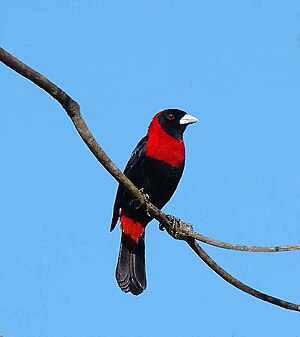Flame tangerine
| Flame tangerine | ||||||||||||
|---|---|---|---|---|---|---|---|---|---|---|---|---|

Flame Tangare ( Ramphocelus sanguinolentus ) |
||||||||||||
| Systematics | ||||||||||||
|
||||||||||||
| Scientific name | ||||||||||||
| Ramphocelus sanguinolentus | ||||||||||||
| ( Lesson , 1831) |
The Flammentangare ( Ramphocelus sanguinolentus ) is occurring in Central America species of bird in the family of tanagers (Thraupidae).
features
The flame tangar reaches a body length of about 17 centimeters and a weight of 35.0 to 48.0 grams. The crown, the neck, the chest, the rump and the rump are colored bright carmine red, the rest of the body and the wings are deep black. The control springs are relatively long. The iris is red-brown, the strong beak whitish to light blue-gray. Legs and feet are dark gray. Both sexes hardly differ in color. The females sometimes show somewhat paler colors.
Distribution, subspecies and habitat
In addition to the in the southeast of Mexico in Belize and South honduras occurring nominate Ramphocelus sanguinolentus sanguinolentus another is subspecies known:
- Ramphocelus sanguinolentus apricus ( Bangs , 1908) - on the side of Honduras facing the Caribbean Sea , in the northwest of Panama and on the side of Costa Rica facing the Pacific .
Flame tanagers prefer to inhabit the humid forest edges, rich in bushes, in areas that usually extend from the plains to an altitude of 1200 meters, in Costa Rica sometimes up to 1600 meters.
Way of life
The birds feed on fruits and insects (Insecta). The fruits of black-mouthed plants (Melastomataceae) or figs ( Ficus ) are popular. The flame tangerines live in pairs or in small groups, sometimes in company with other species of tangerines. The breeding season was documented differently from region to region between March and June. The nest is primarily made of moss and leaves and provided with three eggs. These are pale blue in color and have brownish speckles. Further information on breeding behavior is currently not available.
Hazard and protection
The flame tangar is not uncommon in many protected areas and national parks as well as outside such areas and is therefore classified by the World Conservation Organization IUCN as ![]() “ Least Concern = not endangered”. In contrast to many other species, the flame tangerine even seems to benefit from the deforestation of dense forests, as it has colonized new habitats in cleared areas.
“ Least Concern = not endangered”. In contrast to many other species, the flame tangerine even seems to benefit from the deforestation of dense forests, as it has colonized new habitats in cleared areas.
Individual evidence
- ↑ a b c d Hilty, S. & de Juana, E. (2017). Crimson-collared Tanager (Ramphocelus sanguinolentus). In: del Hoyo, J., Elliott, A., Sargatal, J., Christie, DA & de Juana, E. (eds.). Handbook of the Birds of the World Alive. Lynx Edicions, Barcelona. (Retrieved from http://www.hbw.com/node/61624 , on February 20, 2017).
- ^ IUCN Red List
literature
- Josep del Hoyo , Andrew Elliott, David A. Christie: Handbook of the Birds of the World, Tanagers to New World Blackbirds. Volume 16, Lynx Edicions, 2011, ISBN 978-84-96553-78-1 .
Web links
- neotropical.birds - Neotropical Birds
- itis.gov - ITIS Report
- xeno-canto - spread
